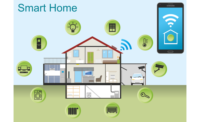Although still in its infancy, the global do-it-yourself (DIY) market for devices with added smart connectivity is forecast to experience a steady rate of growth at 22.3 percent annually from 2016 to 2021. While the Americas region accounts for 83 percent of the global DIY revenues as of 2016, Asia and EMEA have yet to adopt DIY systems on a wider scale. Lower costs of labor and relatively low familiarity with the benefits of connected devices, as well as interoperability issues, continue to stifle demand for DIY systems in these regions.
There are several factors that make DIY systems more attractive to new buyers than professional security systems:
- Comparative costs of installing and operating the system are much lower. The installation of the equipment can be done by the users themselves and only requires basic understanding of technology.
- Monitoring of the alarm can be performed through the dedicated smart phone application, bringing the costs down to nothing and freeing the user of having to join lengthy, costly monitoring contracts.
- Consumers who already have at least one connected device in the home are more likely to consider a DIY security system. Their experience with using connected devices is usually a strong motivating factor in considering a DIY system, most of which have some form of added connectivity enabling the user to control their heating or lights while arming, and monitoring their in-house alarm system.
- DIY systems would also suit residents of rented properties or younger families, who might struggle with maintaining a professionally installed alarm over a longer term due to the accumulation of fees over a longer period. DIY systems would also enable them to avoid fees or the hassle of transferring their alarm system and related contracts to a new property, should they move house.
However, there are several barriers to the wider popular adoption of those systems.
- Even though there isn’t a need for a professional to install the system, interaction with the system might prove quite complicated for users who don’t have an extensive experience with using smart-phones. This has prompted moves by manufacturers to simplify user interfaces and the set up process to make it as seamless as possible and enable all customers to install the systems without difficulties.
- Even though the DIY systems would require no recurring monthly costs to the user, the upfront equipment cost of a DIY system with added functionality is still significant. In the case of Samsung SmartThings the starter package presents an interesting offering, however to cover an entire home for a 4-5 person family the costs of equipment would add up quickly. Prices certainly vary by providers but with professionally installed systems, the customer has the option to spread the costs of the equipment throughout the duration of the monitoring contract, which eases the burden of a starting cost.
- Installing an intruder alarm already increases the safety of the property but its value is fully achieved when that alarm is able to elicit a swift response from a police force or a security response team, and reduce or prevent the loss of goods in the case of an intrusion. The quick reaction and a complete peace of mind are benefits which can only be achieved through a professional monitoring service.
- Users of DIY systems, being unable or uninterested in purchasing a year-long rolling basis monitoring services, would potentially be interested in purchasing a temporary monitoring option to secure their property when away on holidays. However, very few such options are available on the market.
- Commercial users are yet to adopt DIY intrusion solutions. The barriers here seem to be significant, however. Commercial customers face much higher levels of risk to their premises than residential customers, hence the insurance requirements for quality and compliance of intrusion equipment with relevant regulations is much higher. Currently available DIY systems do not conform to neither national nor international standards regulations and therefore would not be accepted as reliable equipment for insurance purposes.
- There are also specific cultural differences between markets, where intruder alarms are either not considered a necessary option or perimeter security solutions are preferred over in-house intrusion systems. Italy, South Africa and Thailand continue to favor perimeter security solutions, with Italy adopting them in addition to existing ‘in-house’ intrusion detection systems. On the other hand, Japan and Australia are examples of generally safer countries with low crime rates whereby intruder alarm systems are not generally perceived as critical.
Despite the DIY systems market representing only a small fraction of the global intruder alarms equipment revenues it appears to be continuing on an upward trend. In the next few years it may expand to the level where it will begin putting pressure on the professional security companies forcing them to be more creative in efforts to attract new customers and the ways through which they interact with potential customers, as well as increasing the variety of available intruder alarm packages.
There are in fact several ways in which the challenge could be addressed:
- A professional security company could offer DIY solutions while offering their customers options for upgrading to a professionally monitored system after a trial period.
- Discounts on monitoring rates could be applied if the customer upgraded their equipment to a certified type.
- Professional Security companies could also devise an interesting portfolio of monitoring services, including access to a temporary service which could be purchased on a pay-as-you go basis.
- Ensuring that devices offered are interoperable with smart devices will also be key to opening up new market opportunities, particularly in Asia.



